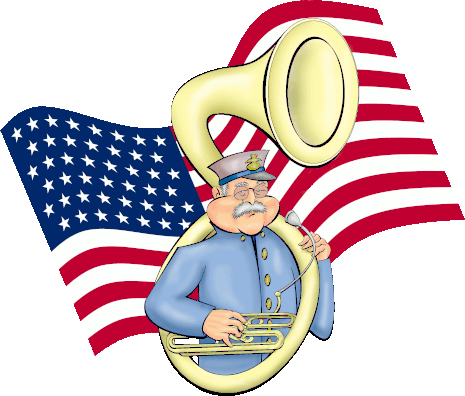John Phllip Sousa
The King

(Click to zoom in and out.)
The March King, that is. And that's a title that is borne without dispute. Big John's 130-plus marches have been played by wind ensembles and orchestras throughout the world. The iconic "Stars and Stripes Forever" was even played by the Military Bands in the former Soviet Union!1
John came from a musical and military family. His dad played trombone in the United States Marine Band, and John himself began playing in that distinguished organization at age 13 as an "apprentice". The story is that he had run away to play in a circus band, and his dad felt having him join up was a way to indulge in the kid's musical ambitions.
Being crowned "The March King" is most apt as it can be argued that John never wrote a bad march. Less known is that John also wrote nearly 200 other compositions. This included songs, dance pieces (including waltzes), suites, humoresques, and fantasies2. He even wrote 11 "light" operas. Every now and then you'll find some modern performances featuring these other works, but the truth is that for better or worse, when people want to hear John Philip Sousa, they want to hear his marches.
Footnote
The meaning of these specific types of compositions is less familiar to the general public than in John's day and may require a bit of elaboration.
A song meant a short stand-alone musical composition usually with words. They were generally adaptable to amateur singers and did not require great vocal ability.
Dance pieces are just that. Instrumental compositions intended for dancing. A waltz is a moderately paced dance tune in 3/4 time.
Suites are instrumental compositions with several movements usually in the same key.
A humoresque is a short instrumental piece where the tune is supposed to convey a whimsical or fanciful mood. It's not necessarily intended to be funny per se, but more of a "good humored" character.
Finally, a fantasie (also called fantasia or fantasy) is a composition usually written for a single instrument and which has no specific form and is intended to convey a feeling of improvisation.
John led the Marine Band from 1880 to 1892. He then left to conduct his own band. There was an immediate outcry from some quarters as this seemed to be selling out and truth to tell exactly why he left the service isn't known. That there could have been mundane reasons can't be denied. As a private citizen John would make a lot more money.
On the other hand, we know that John had also been a bit miffed with the slow pace of promotion in the peacetime service. From 1880 to 1885 he was leading the premiere military ensemble in the country but his rank was only that of a private. Some authors say he was bumped up to a sergeant major after 1885, but this isn't completely clear. For his part, John felt he should actually receive a commission, and later directors were indeed officers.
Eventually John got his promotion but it took a while. With the advent of the First World War in 1917, the 62-year Marine veteran joined the Navy as a band leader and was made a lieutenant3.
Footnote
John's successor as the Marine Band conductor was Francesco Fanciulli who irritated the civilians and soldiers alike by avoiding playing Sousa marches. Finally one officer got fed up with no Sousa and ordered Francesco to play "El Capitan". Francesco still refused and was ordered back to the barracks under arrest. He was court-martialed for disobeyance of a direct order, found guilty, and ordered dismissed from the service. However, the then Secretary of the Navy, Teddy Roosevelt, thought the punishment too harsh and granted Francesco a pardon. Although he returned to leading the band, later in the year he was refused reenlistment as the opinion was that discipline might suffer if he continued to serve.
But for all the marches and music, there's yet another legacy that Big John left that has been every bit as enduring. And to learn what that legacy is - and no, we don't mean using his march "The Liberty Bell" as a theme song for a comedy group - you can just click here.